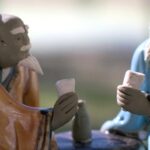“For me, the cinema is not a slice of life, but a piece of cake”. This quote by Alfred Hitchcock embodies the much discussed idea that he was an auteur filmmaker. His particular style deals with much of what makes reality worth living, and not so much of what makes it dull and repetitive. This is why I believe that Hitchcock is much more a formalist auteur than what his films are currently regarded as.
Of course, his films as almost any other genre must be grounded in realism for the sake of audience comprehension, but it is Hitchcock’s unique approach which creates an atmosphere that is mysterious, enjoyable, and fascinating. His film North by Northwest is one of those outings that personify many of those qualities. Editing and sound are two of the most used techniques for audience manipulation and Hitchcock controlled them meticulously in this film. The use of editing, sound, and in-studio sets in North by Northwest directly relate to the idea of Hitchcock as a considerably mindful formalist auteur.
The film in question was released into theaters in 1959 and eventually became the sixth highest grossing film in that year. It can with much certainty be called a heavily plotted screenplay where there are many locations as well as various characters who voluntarily and involuntarily switch their identities, which can be seen as one of the films’ many motifs. Hitchcock’s trademark “macguffin”, which is the thing in the film that the audience is looking for the entire film and therefore seems to drive the plot, can be seen as two different devices throughout the film.
The first could be the mistaken identity of the agent George Kaplan, but once that is revealed as being no one and then occupied by the main character, Roger Thornhill, it switches to the secret information that is sought by the government that Vandamm possesses. Personally, I find the film to be Hitchcock’s most purely enjoyable outing in that his intention was to keep the symbolism that was so prevalent in most of his films absent. Many of the specifics and trademarks of Hitchcock’s filmmaking are present in this film including, high overhead camera angles, point-of-view shots, magnificent Bernard Herrman music, and of course his cameo appearance. This was basically the last manifestation of the Hitchcock theme of the innocent man wrongly accused in his filmography, but the characteristic of acute paranoia is always present.
Also, I have found that a common theme in many of Hitchcock’s films is one that involves heights or a fear of heights. Although North by Northwest does not portray an intense fear of heights but it does have an important climactic scene involving heights much like his previous film; Vertigo. When it opened, audiences celebrated Hitchcock’s return to adventure stories; as some of his other films like Strangers on a Train, Rear Window, and Vertigo dominated with their suspense and intense psychological undertones. This was the return of fantastic events, enjoyable mystery, and prevailing love.
When speaking on the subject of editing in any Hitchcock film, the one of the first concepts that must be pointed out is the influence that soviet montage has on Hitchcock’s own editing style. Soviet montage is a style of editing that was used by a group of Russian filmmakers in the 1920s and 30s with Sergei Eisenstein being one of the most famous Soviet montage theorists. The main belief among these theorists is that editing is the most important aspect of filmmaking and that short cuts among certain imagery can be extremely effective in manipulating an audience. Hitchcock uses many short cuts involving various images in his films. In North by Northwest the main images that seem to be inter-cut are Thornhill, his constant chasers, the various modes of transportation that are used, as well as some of the American landmarks that are portrayed throughout the film.
Most of the film is edited along a rather brisk pace keeping along with the idea that Thornhill is constantly being chased by various people on his journey including Vandamm and the police. However, there are several sequences that have almost an entirely different editing style in order to infer to the audience that they have been transported to an alternate area that has its own set of rules.
The film opens with a bombardment of the hustle and bustle of Manhattan in an editing style that perfectly fits that message using a series of relatively quick cuts from one crowded area to another. The sequence ends when Hitchcock produces his cameo appearance being cut off from entering a bus when its doors close and it subsequently drives away. But when Thornhill first exits an elevator and enters the screen there is a somewhat long take of him relaying assorted information to his assistant. The purpose of this is to introduce the main character in a way that the audience can become familiar with him and therefore understand the fast and to the point way he talks, the stylish way he walks, and also the way he always seems to be enjoying himself almost too much. The introduction of Vandamm’s two henchmen is unique because of the fact that it is so exaggerated. Instead of a quick cut to their faces, Hitchcock uses a simple cut to face their direction a sped up dolly shot that moves right up to where they are standing to emphasize that they are the bearer of the starting point for the plot.
The first sequence where the editing pace increases significantly is where Thornhill is forced to drive a car while drunk. Cuts of Thornhill trying desperately to stay awake, the road and any cars in front of him, and the henchmen chasing him are all inter-cut. Once he is on the train with Eve Kendall the pace dies down but there is a clever shot designed to blend the inside of the train which is shot in the studio and the footage of the outside of a moving train. The camera pans to the edge of the window and then a cut is placed while the frame is still on the window sill so that the cut almost looks seamless.
As Thornhill moves to the cornfield to meet the non-existent Kaplan the editing pace immediately slows down as long takes spend the time to watch each car drive by one by one in order to show the audience the dramatic journey Thornhill has made thus far. With this effect as well as the sound differences, the cornfield feels like he landed on a different planet. The long takes also signify that this is a place where there is nowhere to hide; unlike the many corners of the city that brings along quick cuts, the cornfield portrays a lack of shelter in its long takes. The pace does pick up a little for the subsequent plane chase but Hitchcock keeps the audience in the mood when the plane looks like it’s a long way off and then plunges just inches over Thornhill’s head.
Much of the editing is then uniform until the climax approaches at Mount Rushmore. The editing does pick up at this point but the significant increase occurs when Kendall steals an idol containing the sought after information right out of Vandamm’s hands. This increased pace continues right through many of the close calls on the edge of Mount Rushmore. After the last of the henchmen is killed while trying to push them off the monument, there is a partial jump cut when Thornhill finally tries to pull Kendall to her safety, to him pulling her up onto his bed back on the train. I believe that this particular use of editing directly relates to Hitchcock as a formalist auteur because as a formalist, the time period between those two moments is not entirely important to the conclusion of the film. It is not necessarily crucial that you see how Thornhill and Kendall get to safety in this type of adventure film, but a realist might be forced to explain each event no matter how insignificant it might be for the sake of portraying actions as close as possible to the way they might play out in reality.
Sound is an expressive way to manipulate the audience by an auteur because much of it goes unnoticed by the viewer who is so intent on concentrating on the visual aspects of the film. As the film opens in the crowded city, and during the introduction of Thornhill, we hear amplified sounds of some general sounds of the city including car horns, engines, and jumbled pieces of conversations. But what seems to be a motif throughout the film, there also is a sound that does not belong in the city; it sounds like a plane engine swooping up and down across the sky. This sound is by no means apparent to the audience, but I believe that this does occur during those first few scenes in the city as a technique of foreshadowing of things to come. Then comes the famous cornfield sequence, where every sound that comes from a different mode of transportation is amplified because of the lack of outside noise from the city. As every car drives by we hear the engine first from a distance, it becomes louder, and then passes away again.
The effect of the plane engine does the same thing except it stays hovering above Thornhill for a longer period of time along with coming much closer so that the sound has an overall louder amplification. There is another important moment in sound when Thornhill and the government agent are walking through the airport runway while going to the plane to take him to Mount Rushmore. The agent says that he is going to explain everything about the situation up to this point about Kaplan and Vandamm and just as he begins to do that a loud plane engine drowns out his voice so that we do not have to hear what we have seen, or even what is still left to be found out in the film. This use of sound is clearly formalistic in its exact timing and is definitely an auteurist use of sound.
The music in the film is one of my favorite scores and themes written by the legendary Bernard Herrman. It is classic in the way that it uses its themes as motifs throughout the film, and highlighting the key events as they happen to Thornhill. However, the way that Hitchcock uses this music is what defines him as an auteur. We all know many of the famous uses of sound in Hitchcock films like the high pitched strings in Psycho, but in North by Northwest the cornfield sequence is where the brilliance lies. During this sequence the music disappears and the only sound we hear is the cars and eventually the plane. It is not until the explosion of the collision with the oil truck that the music returns. The effect that this silence has on the aura of the cornfield is similar to the effect that lack of editing has; the cornfield seems almost alien compared to the happenings of the city. Bernard Herrman is one of my favorite composers, but any music cannot just be entered into the background of a film, it is what Hitchcock does with Herrman scores that truly make them enhance a film’s effectiveness.
If he was forced to choose between shooting any given shot in the studio, or on location, Alfred Hitchcock would most definitely choose the studio. One of the main reasons for his choice would be because in the studio he could control countless more outside factors in order to get the exact shot he wanted. And I am almost certain that he kept the set designers busy on North by Northwest because there were numerous sets to build. Clearly some of the sets on a film must be built in the studio or on the back lot because of several uncontrollable factors including the safety of actors, cost restrictions, and logistical issues including booking problems. The fact that it was Hitchcock’s preference is also what contributes to the idea that he is a more formalist auteur.
For example, the production was not allowed to film at the United Nations; so Hitchcock sent a guerrilla team to shoot some exteriors for the main building and built every room Thornhill entered in the studio. This allowed him to shoot for as many days as possible for the purpose of getting an important scene where Thornhill is framed just exactly right. Also, the production was not allowed to film anyone walking over the heads on Mount Rushmore, but there was a compromise for filming on the sides of them. The set designers built as much as possible in the studio, so that each time a character fell lower, there would be no issues involving safety as well as time constraint problems since filming action scenes is very time consuming.
Another subject involving sets is matte paintings and rear projections. There is a scene when Thornhill and Kendall get off of the train and walk towards the exit of the station trying to avoid getting caught by the police. This entire sequence is a rear projection with the two actors pretending to walk in front. This is another example of Hitchcock attempting to control his environment as much as possible to where there are no problems on where the actors should walk, where the extras are in the background, or even setting up the placement of the camera and other technical issues.
Also, Hitchcock can have almost as many takes as he wants with a rear projection. One of the most famous rear projection scenes is on the cornfield where Thornhill is being chased by the plane. As he continues to run away every time the plane swoops down, he jumps out of the frame and then there is a cut of him falling onto the corn on the ground. Hitchcock shot the cornfield location footage before the actors ever came onto the set so that he could give Cary Grant his trademark exact instructions on which direction to move. Hitchcock was infamous for his meticulous directions to actors, which angered some method actors like Paul Newman in certain situations. However, this is absolutely one of the reasons for a film eventually turning out exactly as he envisioned it in his head.
In the film, as Thornhill gets into a cab with his assistant during the opening sequence he says, “…in the world of advertising there’s no such thing as a lie, there’s only the expedient exaggeration …” I believe that this quote is directly related to the way that Hitchcock films his stories. With North by Northwest he has populated a world made up of the characters he desires, the places he desires them to go to, and with the events that he wishes would happen to them. The result is definitely not something that every director gets to film in his lifetime; this world is perfect.
Hitchcock himself once stated that “Drama is life with the dull bits cut out.” Also, in the film when Hitchcock wants the audience to notice something important he typically uses an exaggerated dolly shot instead of editing. It generally makes the shot much more dramatic and cinematic. It also serves the purpose of the audience being more aware of the movement because camera movement is slower than increased editing. It is shots like these that accentuate certain plot points to exactly what makes an enjoyable film like this work. I also believe that throughout the film there is a motif that can be seen throughout Hitchcock’s entire filmography; various modes of transportation. There are planes, trains, cars, and one’s own legs can also be counted. I only wish that he somehow put a lifeboat in this film just for kicks. All of this does basically equal his particular style, which can be traced back to auteurism. He clearly has a similar style that he uses throughout all of his films, and as he once said, “Self-plagiarism is style.”
Works Cited
North by Northwest. Alfred Hitchcock. Film. M-G-M, 1959.
Brainy Quote. BrainyMedia.com. 2007. March 15, 2007.
“North by Northwest”. Turner Classic Movies. A Time Warner Company. 2007.
December 16, 2007. http://www.tcm.com/thismonth/article/?cid=104717&rss;=mrqe
“The Internet Movie Database”. IMDB. Internet Movie Database Inc. 2007. December 16, 2007. < http://www.imdb.com/>





